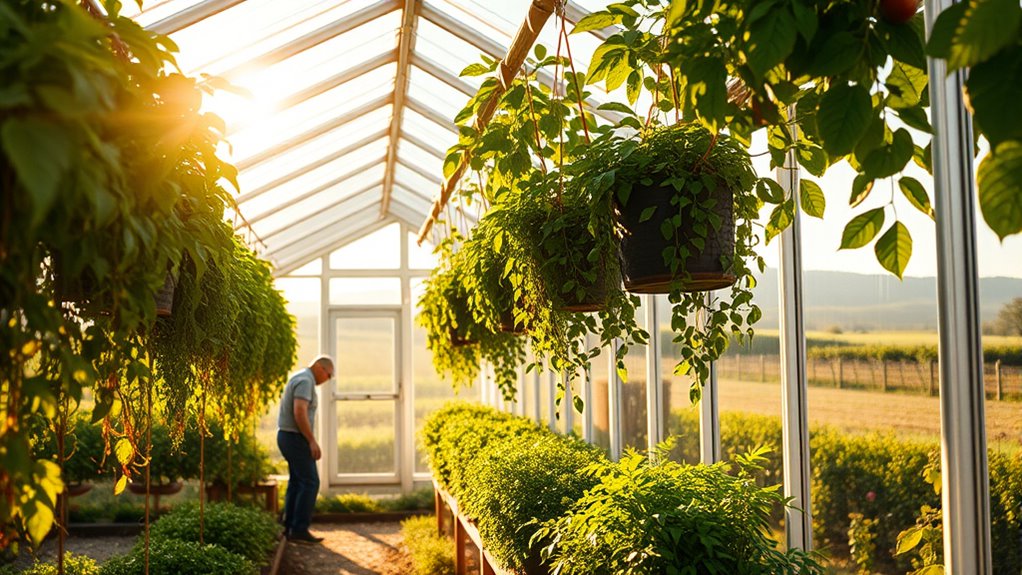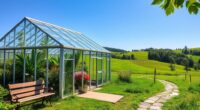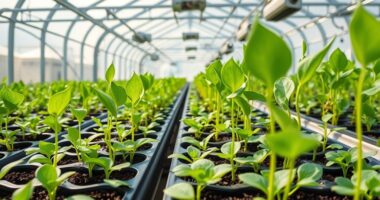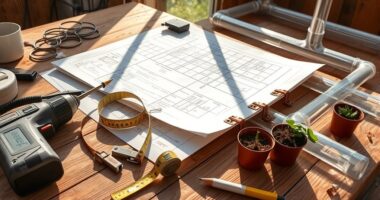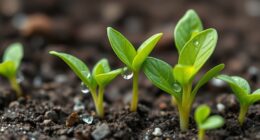Investing in a greenhouse helps you extend growing seasons, boost crop yields, and diversify your harvest, all while controlling environmental factors for ideal plant health. Greenhouses lower energy costs through efficiency and promote sustainability with eco-friendly features. They also allow for year-round gardening, giving you fresh produce anytime and reducing reliance on chemical treatments. Curious how these benefits can transform your gardening or farming efforts? Keep exploring to discover all the long-term advantages.
Key Takeaways
- Extends growing seasons and boosts yields through controlled environments, maximizing land use and increasing profitability.
- Enhances environmental control for optimal crop conditions, improving quality and reducing resource waste.
- Reduces energy costs with efficient insulation and renewable energy, ensuring long-term cost savings.
- Promotes sustainability by lowering carbon footprints, conserving water, and using eco-friendly materials.
- Enables year-round cultivation, ensuring continuous supply, market adaptability, and strategic growth opportunities.
Extended Growing Seasons and Increased Crop Yields
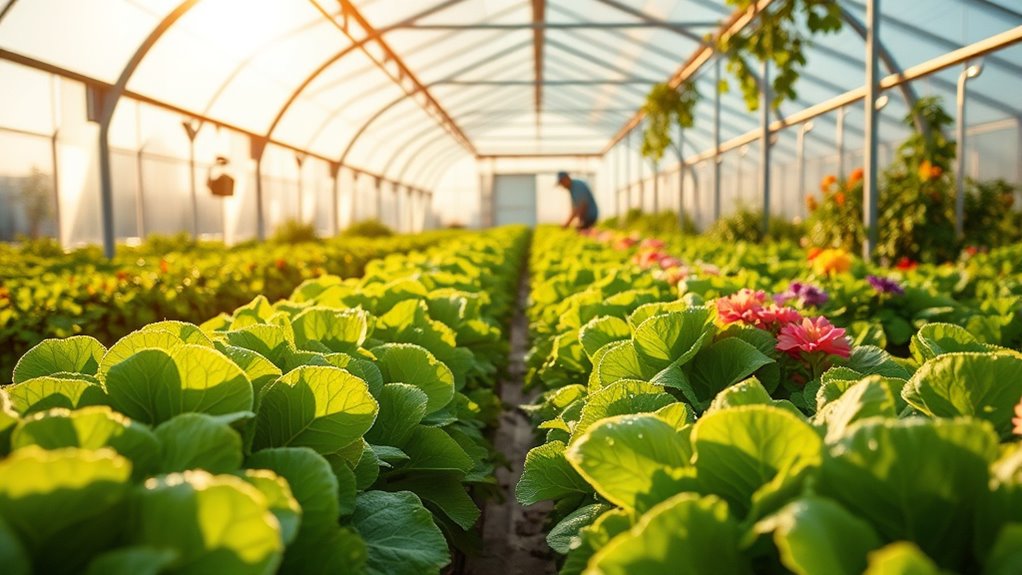
Greenhouse investments allow farmers to extend their growing seasons beyond traditional limits. With a controlled environment, you can optimize soil health by managing conditions that promote nutrient retention and reduce soil degradation. Organic seed cultivation practices within greenhouses further improve soil quality and crop health. This control helps maintain fertile ground for continuous cropping, boosting overall productivity. Additionally, greenhouses provide a physical barrier against pests, making pest management easier and more effective. You’ll spend less on chemical treatments and reduce crop losses caused by pests. As a result, you can harvest more crops throughout the year, increasing your yields considerably. This extended growing window not only maximizes land use but also enhances your ability to meet market demands consistently. Investing in a greenhouse empowers you to grow smarter, healthier crops with fewer setbacks.
Enhanced Control Over Growing Conditions
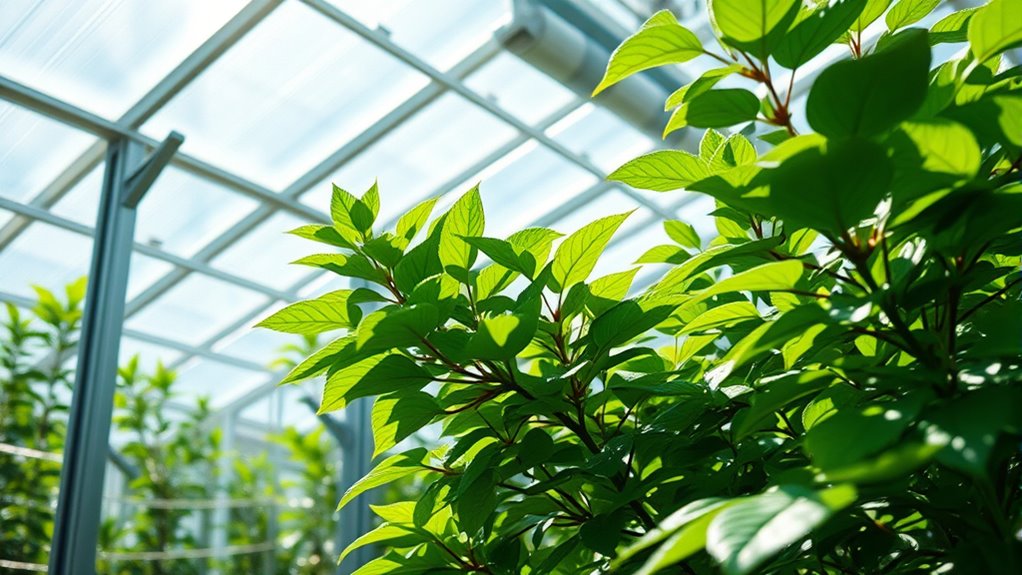
With a greenhouse, you can precisely control temperature, ensuring ideal conditions for your crops. You also manage humidity levels to prevent disease and promote healthy growth. Additionally, adjusting light exposure helps you maximize photosynthesis and yields year-round. Moreover, building a greenhouse can lead to reduced reliance on external weather conditions, giving you more consistent harvests throughout the year. This control over environmental factors can also help extend your growing season, allowing for more diverse and continuous crop production. Implementing environmental controls can further optimize growth conditions and improve overall productivity, especially when integrated with advanced climate management systems. The use of advanced materials in greenhouse construction can further enhance insulation and energy efficiency, reducing operational costs over time.
Temperature Regulation Precision
Thanks to advanced climate control systems, you can now precisely regulate temperature within your greenhouse, ensuring ideal conditions for plant growth. This control relies on key factors like ventilation efficiency and insulation quality. Additionally, integrating AI-driven diagnostics can help optimize system performance and detect potential issues before they affect your crops. Imagine:
- Automated vents opening at the perfect moment to release excess heat, maintaining a stable environment.
- Thick insulation walls minimizing heat loss during cold nights, keeping temperatures consistent.
- Sensors continuously monitoring conditions, adjusting heating or cooling to prevent fluctuations and maintaining optimal temperatures. Proper climate regulation is essential for consistent crop health and productivity.
- Using high-quality insulation materials further improves temperature stability and energy efficiency.
With enhanced temperature regulation, you avoid stress on plants caused by sudden changes. These systems create a seamless environment where your crops thrive, improving growth rates and yields.
The combination of ventilation efficiency and insulation quality guarantees your greenhouse remains a highly controlled space, giving you peace of mind and better results.
Humidity Level Management
Effective humidity management builds on precise temperature control by creating the ideal environment for your plants. Proper humidity levels help prevent issues like mold and fungal diseases, ensuring healthy growth. Good air circulation is essential, as it helps distribute humidity evenly across your greenhouse. A new sentence with expert voice actors and the rest of the sentence. By maintaining perfect humidity, you promote better air circulation, which reduces excess moisture around your plants. This not only supports consistent growth but also minimizes the risk of mold buildup on leaves, stems, and soil. Using humidifiers or dehumidifiers as needed allows you to fine-tune humidity levels easily. Additionally, understanding indoor air quality can help in optimizing the overall environment for your plants. Moreover, monitoring greenhouse operating hours can help you align your climate control systems for maximum efficiency. Incorporating AI-driven climate modeling can further enhance your ability to maintain optimal humidity levels, reducing manual adjustments and improving overall plant health. Maintaining a balanced humidity level is crucial for preventing plant stress and promoting vigorous growth. With enhanced control over humidity, you create a stable environment that fosters healthy plant development while protecting your investment from mold-related problems.
Light Exposure Control
Controlling light exposure is crucial for optimizing your greenhouse environment and promoting healthy plant growth. You can harness natural light to maximize photosynthesis or supplement with artificial lighting when daylight is limited. This control allows you to tailor conditions precisely. For example, using lighting systems can help extend daylight hours or improve light quality for your plants. Imagine:
- Adjusting shading screens to block harsh midday sun, preventing leaf scorch.
- Installing grow lights that mimic natural light, extending daylight hours for rapid growth.
- Using reflective surfaces to evenly distribute light across your plants, reducing shadows and promoting uniform development.
Cost Savings and Return on Investment

Implementing greenhouses can lead to significant cost savings by reducing energy consumption and minimizing resource waste. With improved energy efficiency, you’ll lower heating, cooling, and lighting expenses over time. Utilizing energy-efficient technologies further enhances these savings by optimizing resource use and lowering operational costs. Additionally, the adoption of innovative climate control systems can help maintain optimal conditions and reduce waste. Incorporating advanced insulation materials can further improve temperature retention, leading to additional energy savings. Although initial costs for setup and equipment can be substantial, they often pay off through reduced operational expenses and higher crop yields. Greenhouses allow you to control environmental conditions precisely, leading to faster growth rates and better-quality produce, which boosts sales and profitability. Moreover, local specialties and artisanal items attract regional customers, expanding market opportunities. Additionally, the ability to extend growing seasons increases your overall productivity. Over the long term, these benefits combine to provide a strong return on investment, making a greenhouse a financially sound choice. Proper planning and efficient design ensure that your investment delivers ongoing savings and growth opportunities.
Environmental Benefits and Sustainability
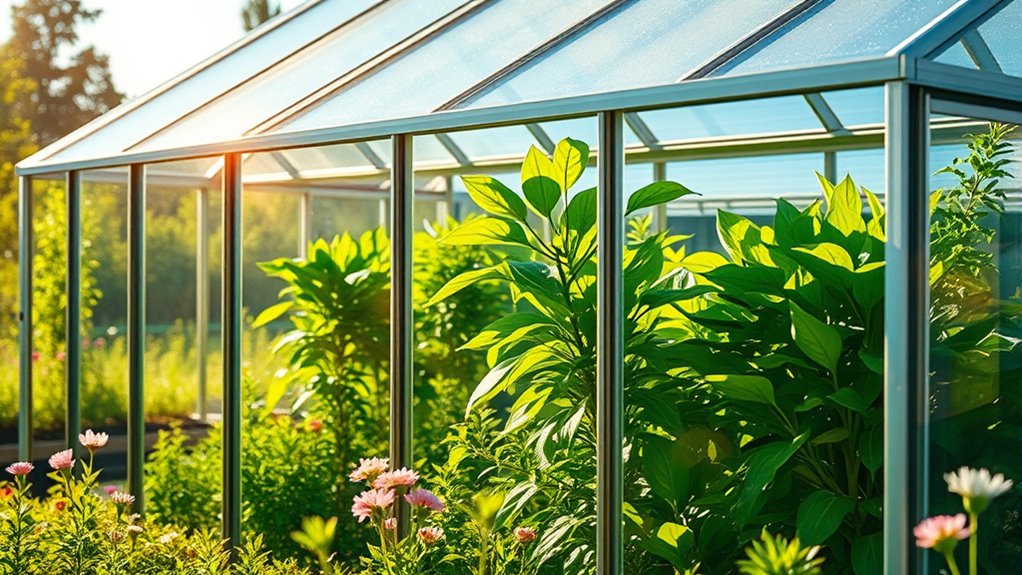
Have you considered how greenhouses can contribute to environmental sustainability? By using renewable energy sources like solar panels, you reduce reliance on fossil fuels, lowering your carbon footprint.
Eco-friendly materials, such as recycled plastics or sustainably sourced wood, help minimize waste and resource depletion. Imagine this:
- Solar panels powering your greenhouse, providing clean energy.
- Recycled materials forming the structure, reducing landfill waste.
- Controlled environments that minimize pesticide use and conserve water.
These practices make your greenhouse environmentally friendly, promoting sustainability. Investing in such features not only benefits the planet but also aligns your operation with eco-conscious principles.
Furthermore, integrating Vetted soaring skyways solutions can enhance the efficiency and eco-friendliness of your greenhouse operations, supporting long-term sustainability goals.
Greenhouses that prioritize renewable energy and eco-friendly materials set a standard for sustainable agriculture, ensuring the long-term health of our environment.
Diversification of Crops and Products
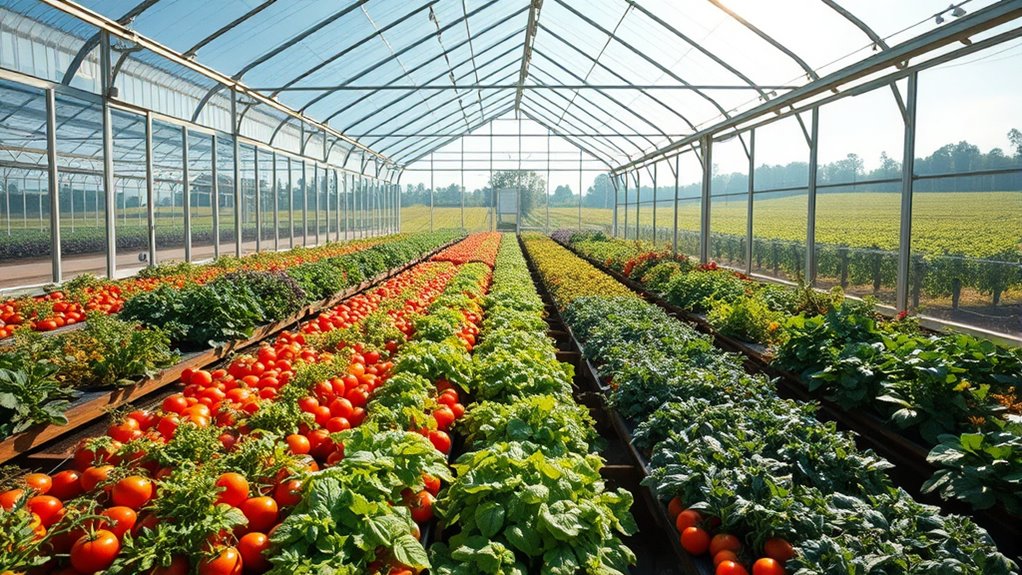
Diversification of crops and products allows you to expand your market reach and reduce financial risks. By growing a variety of plants, you can tap into different customer bases and adapt to changing market demands.
Diversifying crops broadens markets and minimizes financial risks for a more resilient farm.
A broader plant variety also helps buffer against crop failure or price fluctuations, ensuring steady income. Greenhouses make it easier to experiment with new crops or specialty products, supporting market diversification.
This flexibility lets you introduce niche items that set you apart from competitors. With a diverse crop portfolio, you’re less vulnerable to seasonal or regional market shifts.
Ultimately, investing in a greenhouse empowers you to diversify your offerings, increase sales opportunities, and create a more resilient and profitable operation.
Year-Round Gardening and Personal Satisfaction
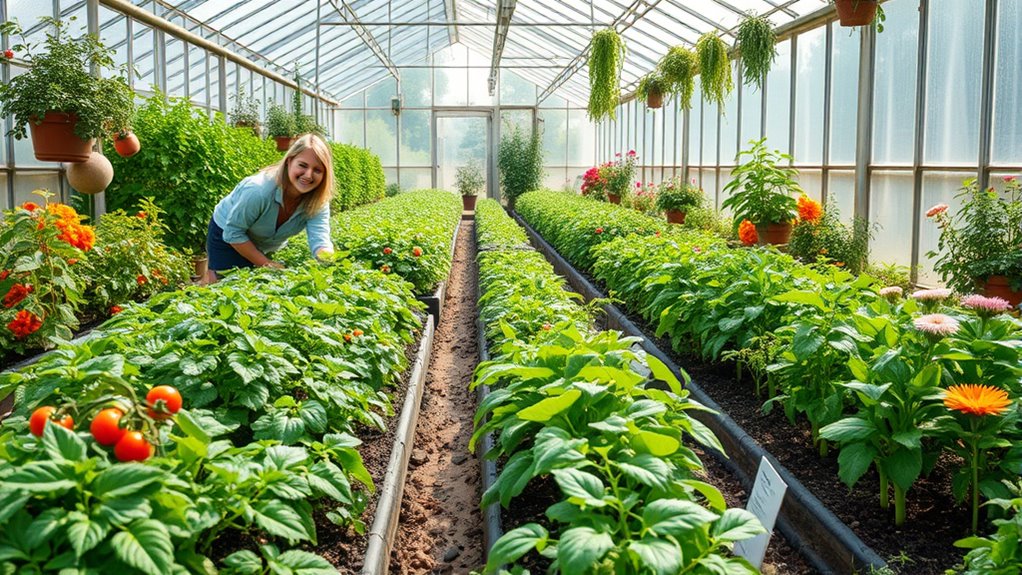
Greenhouses enable you to enjoy gardening throughout the year, regardless of seasonal changes. This means you can cultivate plants whenever you want, providing a sense of personal achievement and joy.
With seasonal adaptation, you can grow crops that mightn’t thrive outside, ensuring fresh produce all year. Pest management becomes easier in a controlled environment, reducing the need for harmful chemicals and protecting your plants.
Imagine:
- Watching vibrant flowers bloom in winter’s cold.
- Harvesting ripe vegetables during off-season months.
- Experiencing the satisfaction of nurturing plants daily, regardless of weather.
This consistent gardening experience boosts your personal satisfaction and keeps you connected to nature, making every day a rewarding gardening adventure.
Frequently Asked Questions
How Does a Greenhouse Impact Local Biodiversity?
A greenhouse positively impacts local biodiversity by supporting native plant preservation and habitat enhancement.
You create a controlled environment that encourages native species to thrive, reducing pressure on natural habitats.
This promotes diverse ecosystems and attracts beneficial insects and wildlife.
What Are the Initial Setup Costs for a Greenhouse?
When considering the initial setup costs for a greenhouse, you should focus on a detailed cost estimation to guarantee accurate financial planning. Expenses include structure materials, heating and cooling systems, ventilation, and lighting.
Costs vary based on size and complexity, so it’s essential to research and budget accordingly. Proper planning helps you avoid surprises, making your investment more manageable and setting a solid foundation for long-term success.
Can Greenhouses Be Automated for Easier Management?
You can definitely automate your greenhouse for easier management. With the automation potential, you can control watering, heating, ventilation, and lighting systems remotely or through scheduled programs. This reduces manual labor and guarantees ideal conditions for your plants.
Automation makes management easier by providing consistent environment control, saving you time and effort. Investing in automation technology helps you maintain a healthy, productive greenhouse with minimal daily oversight.
How Do Greenhouses Influence Water Usage and Conservation?
Greenhouses greatly influence water usage through improved water efficiency and conservation practices. You can implement drip irrigation and recirculate water systems to reduce waste, ensuring plants receive ideal hydration without excess run-off.
By controlling environmental conditions, you minimize evaporation and runoff, promoting conservation. This targeted approach allows you to use water more sustainably, saving resources while maintaining healthy plant growth.
Making greenhouses a smart choice for water-conscious gardening and farming.
Are Greenhouses Suitable for All Climate Zones?
Greenhouses aren’t suitable for all climate zones without adjustments. Climate adaptability depends on regional considerations like temperature, humidity, and sunlight availability.
You might need to invest in heating, cooling, or insulation systems to make your greenhouse work effectively in extreme or unpredictable climates.
Conclusion
By building a greenhouse, you open endless possibilities for prosperity and pleasure. With extended seasons, elevated yields, and eco-friendly practices, you create a sustainable, satisfying sanctuary. The strategic, secure space allows you to diversify, design, and delight in your gardening goals. So, seize the opportunity to transform your terrain into a thriving, timeless treasure—turning your passion into a profitable, personal paradise that prospers season after season.
